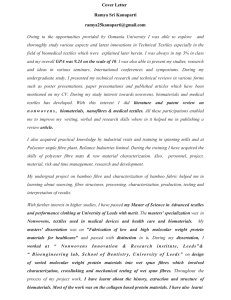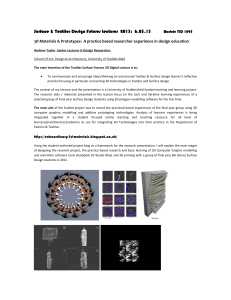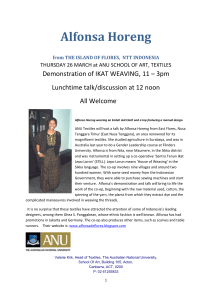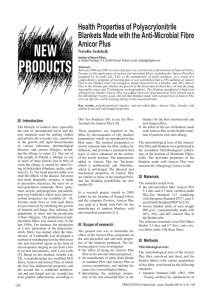Nanotechnology and Textiles
advertisement
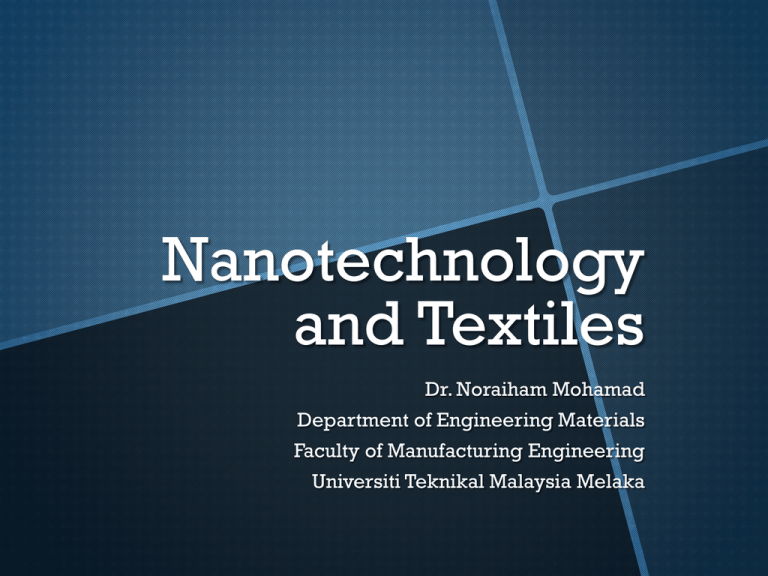
Nanotechnology and Textiles Dr. Noraiham Mohamad Department of Engineering Materials Faculty of Manufacturing Engineering Universiti Teknikal Malaysia Melaka Nano is derived from the Greek word, nanos, meaning dwarf, and in SI units, the prefix nano is used as a factor indicating 10-9. One nanometer (nm) is 0.000000001m By comparison, the diameter of single human hair is 80,000nm, and human red blood cell is 7000nm wide and a water molecule is almost 0.3nm. Both nano-science and nano technology are concerned with materials that are very small. Nano-scale has generally been taken to lie from 0.2nm (atom) to 100nm. Nano-science is defined as the study of phenomena and manipulation of materials at atomic, molecular and macro-molecular scales, where the properties of materials differ markedly from those at larger scale. Nano-technologies, on the other hand, refer to the design, characterisation, production and application of structures, devices and systems, by controlling shape and size at the nanometre scale. Nano-technologies may be considered as a range of methods of manufacturing materials along the lines of atomic assembly. Atoms, molecules and nano- sized materials are thereby manipulated in a thorough, precise and controlled manner to produce novel materials with innovative and different properties to those obtained by conventional material engineering at the micro-scale. Nano-technology has been termed a “bottom-up” technology because of the use of such small scale building units. Conventional materials engineering at the macro-scale is, by contrast, considered as a “top-down” approach. The use of nano-science and nano-technology to control the internal structure of a material at nano-scale is considered to lead to materials with fewer defects and hence of a higher quality. 1. For nano-materials that are 2. nano-scale in one dimesion, application of very thin surface coating (2nm-100nm) to textile materials. Nano-fibres and nanotubes are esentially nano-scale in two dimensions and their utilization in many forms of composite materials offers opportunities to improve the mechanical properties, altering electrical, optical or biological characteristics. 3. The third approach involves the use of nano-particles (nano-scale in three dimensions) for incorporation in fibres, coating, films to provide a myriad of possibilities such as imparting antimicrobial, flame retardant and chemical softening effects to textiles and clothing. Nano-fibres are generally taken to be fibres with a diameter less than 1μm (100nm). Electrospinning is the major fibre production method used to make nano-fibres. In this method a polymer fluid (melt or soloution) is charged with a high electrical voltage and extruded through a spinneret of 0.1-1nm in diameter, the extruded polymer jet being drawn towards an earthered collector. By manipulation of the electrospinning conditions, microfilaments can be produced with different diameters. Nano-fibres produced from synthetic fibre materials can be formed with a high surface area to volume ratio and small pores sizes in fabric form. The potential end uses for such nano-fibres are in filtration, wound dressings, tissue engineering, nanocomposites, drug delivery devices and sensors. Nano-composite fibres consist of nano-fibres containing particles with one dimension in the nano-metre range. The particles may be spheres, fibrils and by varying the amounts, their alignment, and distribution within the nanofibre improvements in the mechanical, electrical, optical or biological properties may be obtained. Nano-composite fibres The carbon nano-tubes essentially consist of tiny shells of graphite rolled up into cylinders, either as single tubes or multiple tubes joined together. The carbon nano-tubes exhibit remarkable properties: ahundred tensile strength some one times that of steel at one sixth of the weight. A thermal conductivity superior to all but the purest diamond; Electrical conductivity similar to copper but with an ability to carry much higher electrical currents. Nano-coating the surfaces of textiles, clothing and textiles for footwear is one approach to the production of highly effective anti-microbial treatments for killing the bacteria that can lead to malodour formation. electrical currents. The nano-coating is held on the fibre surface by strong electrostatic and hydrogen bonds and punctures the bacterial wall, killing bacteria that can accumulate in textiles and clothing through the retention of human respiration exuded through physical activity and wear. Nano-coating of textile fabrics, complete finished garments or shoes can be obtained by plasma polymer treatment. Plasma is the fourth state of matter (after solid, liquids and gases) which was proposed by Sir William Crookers, as a result of experiments in the passage of electricity through gases. Aelectrical plasma generated by discharge through gas consists of a mixture of positive and negative ions, electrons, free readicals, ultraviolet radiation, and many different electronically excited molecules. By vary the conditions of the plasma treatment and the nature of the specific gas presents, a variety of surface treatments can be produced that change the chemical or physical nature of the fibre surface, thereby radically altering all treatments that depend upon fibre adhesion, eg coating, lamination and bonding. Nano Technology Nano-particles are permanently attached to cotton or synthetic fibers. The change occurs at the molecular level, and the particles can be configured to imbue the fabric with various attributes. Nanotechnology combines the performance characteristics associated with synthetics with the hand and feel of cotton Nano-fibers attached to cotton fibers Nano-fibers cause liquids to roll off Nano-fibers 1/1000 the size of a typical cotton fiber are attached to the individual fibers. The changes to the fibers are undetectable and do not affect the natural hand and breathability of the fabric Microbes Begone! An anti-microbial technology has been developed by which it embeds AgION™, a silver-based inorganic zeolite, in a solution-dyed polyester Fossfibre® bicomponent fiber. Fossfibre with AgION is suitable for all textile applications in which anti-microbial protection is desired. The bicomponent fibers in Fossfibre are specially designed so that AgION is found only on the sheath, providing controlled release for optimum exposure to the destructive bacteria. The silver ions from the ceramic compound are released at a slow and steady rate. Ambient moisture in the air causes lowlevel release that effectively maintains an anti-microbial surface. As the humidity increases and the environment becomes ideal for bacteria growth, more silver is released. Future prospects The main trust in nano-technologies applied to textiles, clothing and footwear will be to: Improve the properties and performance of existing materials; Develop smart and intelligent textiles with novel functions; Greatly increase the use of fibres in technical textiles, biomedical and healthcare options; and Open up new opportunities for fibres as sensors. Overall, nano-technologies offer great potential for the future and could radically change consumer perception of what constitutes a “standard” apparel fabric.

